The Sift: Misinformation generation | Ballot rumors | L.A. Times’ ‘history of racism’
|
|
Teach news literacy this week |
|
Misinformation cuts across generations Two new studies tap into the growing interest in generational differences when it comes to misinformation savvy. The big takeaway? While it’s easy to blame others for spreading so-called fake news, young and old alike struggle to navigate today’s tangled information landscape.
|
 |
|
Viral rumor rundown 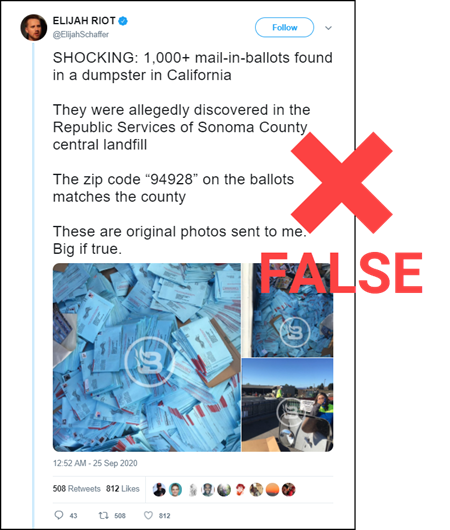 NO: The envelopes in these photos do not contain ballots. YES: They are empty envelopes that once contained mail-in ballots from the 2018 midterm election, and were retained for 22 months under state law. YES: They were recently discovered in a landfill in Petaluma, California, near Sonoma. NO: They are not related to the 2020 U.S. presidential election. NO: Mail-in ballots will not be sent out in Sonoma County until early October.
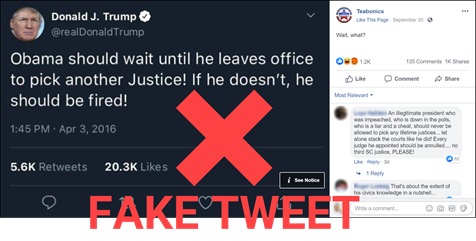 NO: This is not an authentic tweet from President Donald Trump. YES: It’s a fake tweet created to look like an authentic tweet from Trump. YES: As a Republican candidate for president in March 2016, Trump said, at least twice, that then-President Barack Obama should let the next president pick a Supreme Court nominee to replace Justice Antonin Scalia, who died in February 2016.
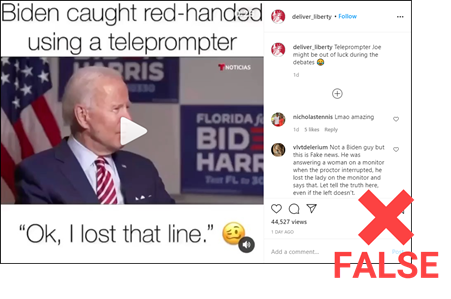 NO: Democratic presidential nominee Joe Biden did not use a teleprompter during an interview with José Díaz-Balart on Noticias Telemundo on Sept. 15. YES: Biden was watching video of a Telemundo viewer asking him a question. NO: Biden did not later say, “I lost that line,” when the screen went black. YES: Biden said, “I lost that lady.” 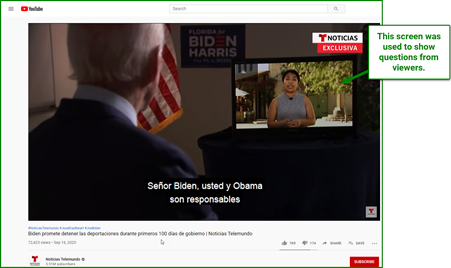 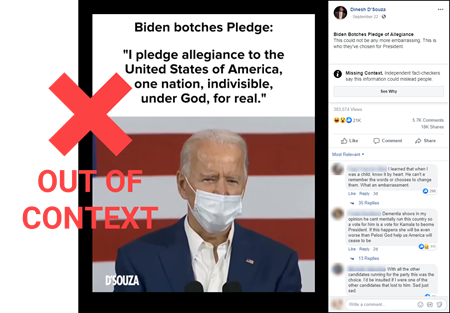 NO: Joe Biden did not botch the Pledge of Allegiance in a recent speech. YES: The above quote is technically accurate, but taken significantly out of context. NO: Biden was not trying to accurately recite the pledge when he said this. YES: Video of the speech clearly shows that this meme is misleading. 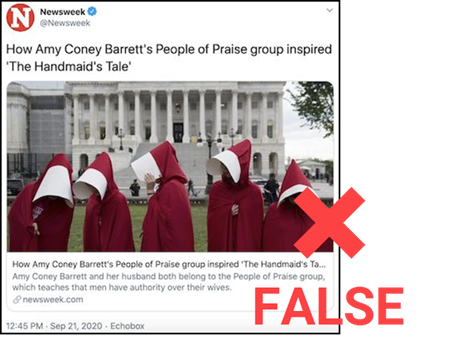 NO: A Christian group that Supreme Court nominee Amy Coney Barrett is affiliated with did not inspire Margaret Atwood’s 1985 novel The Handmaid’s Tale on which the popular television series is based. YES: Barrett has connections to People of Praise, an interdenominational, faith-based organization whose members are assigned an adviser to help guide their life decisions. YES: The group once used the term “head” for advisers who are men, and “handmaid” for advisers who are women. YES: People of Praise endorses the belief that husbands are the heads of their households. YES: The group stopped using the terms “head” and “handmaid” some time after Atwood’s novel became popular. YES: Atwood told The New York Times in 1986 that the novel was inspired by “a Catholic charismatic spinoff sect, which calls the women handmaids.” YES: In subsequent interviews about the book, Atwood has indicated that a different organization that refers to wives as “handmaids” — called People of Hope — was the inspiration for her novel. YES: Newsweek published a report (original here, corrected version of the story here) on Sept. 21 with a headline that included the false claim that People of Praise (the group to which Barrett belongs) was Atwood’s inspiration.
|
|
News Goggles News organizations race to relay information to audiences as quickly as possible when major stories break. One way they do this is by sending breaking news alerts to people who have their apps installed on their mobile devices. This week, we’ve selected a sample of alerts sent on Sept. 23, following the decision by a grand jury not to charge any officers in the fatal shooting of Breonna Taylor in Louisville, Kentucky — and to charge one of them in connection with shooting into a neighboring apartment. |
|
★ Sift Picks Hannah: “What To Do If Your Family Or Friend Shares Misinformation On Facebook” (Brittany Wong, HuffPost). Peter: “Editorial: An examination of The Times’ failures on race, our apology and a path forward” (The Times Editorial Board, Los Angeles Times). Suzannah: “Maria Ressa Says Disinformation Is More Insidious Than We Think” (Gregory Barber, Wired). |
 |
|
What else did we find this week? Here's our list. |
|
Thanks for reading! Your weekly issue of The Sift is created by Peter Adams (@PeterD_Adams), Suzannah Gonzales and Hannah Covington (@HannahCov) of the News Literacy Project. It is edited by NLP’s Mary Kane (@marykkane). |
|

